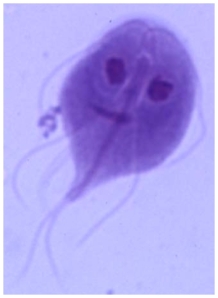
With the rainy weather upon us, it’s very imporant to know the dangers that your dog could face by drinking from puddles or still water.
What is Giardia?
Giardi – are sometimes confused with worms becuase they invade the gastrointestinal tract and can cause diarrhea. They in fact are not worms; instead, they are one-celled parasites that look like cartoon characters classified as protozoa. 
Most dogs that are infected with Giardia do not have diarrhea or any other signs of illness. When the eggs (cysts) are found in the stool of a dog without diarrhea, they are generally considered a transient, insignificant finding.
How does my dog get Giardia?
A dog becomes infected with Giardia when it swallows the cyst stage of the parasite. Once inside the dog’s intestine, the cyst goes through several stages of maturation. Eventually, the dog is able to pass infective cysts in the stool. These cysts lie in the environment and can infect other dogs. They may able be transmitted through drinking infected water.
Life cycle of Giardia:
Giardia occur in two forms: a motile feeding stage that lives in the intestine, and a non-motile cyst stage that passes in the feces. The giardia trophozoite, which is the active stage of the organism – inhabits the small intestine of the dog. The trophozoite stage is tear-drop shaped, binucleated, and has four pairs of flagella. It attaches to the cells of the intestine with its adhesive disc and rapidly divides to produce a whole population of trophozoites. As they detach they may be swept down the intestine. If intestinal flow is fast then they may appear in the feces. However, if they have time, encystment occurs as the parasite travels to the large intestine. The cyst is fairly resistant, and can survive for several months outside of a host’s body as long as sufficient moisture is provided. The cyst is oblong in shape with four nuclei that are sometimes distinctly visible. Mature cysts are usually found in the feces of infected animals. Other animals become infected by ingesting the cysts that passed from the body in feces. These ingested cysts then break open inside the small intestine to release the motile feeding stage (trophozoite). Giardia increase their numbers by each organism dividing in half which is called binary fission.
How is giardiasis diagnosed?
Giardiasis is diagnosed by a microscopic examination of a stool sample. The cysts are quite small and usually require a special floatation medium for detection, so they are not normally found on routine fecal examinations. Occasionally, the parasites may be seen on a direct smear of the feces. A blood test is also available for detection of antigens (cell proteins) of Giardia in the blood. This test is probably more accurate than the stool exam, but it requires several days to get a result from the laboratory performing the test.
How is giardiasis treated?
The typical drug used to kill Giardia is metronidazole, an antibiotic-type drug. it is given for 5 to 7 days. Other drugs are also used if diarrhea and dehydration occurs. If metronidazole is not effective, others are available.
Can humans become infected with Giardia?
Yes, Giardia can also cause diarrhea in humans. Therefore, environmental disinfection is imperative. The use of chlorine bleach, one cup in a gallon (500 ml in 4 liters) of water, is effective if the surfaces and premises can be safely treated with it.
- Giardia in dogs can cause diarrhea, vomiting, weight loss, poor condition, or death. However, many infected dogs show no symptoms.
- People can get giardia, causing diarrhea or other problems, but rarely from dogs.
- Dogs get giardia from water that has been soiled with feces. Give your dog safe, clean water to drink.
- Pick up your dog’s feces immediately, avoiding contact with your skin.

没有评论:
发表评论